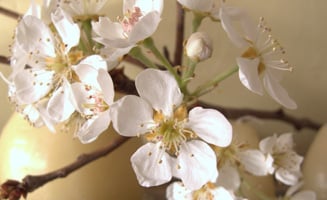

Contributor

Cheat winter by forcing branches of spring-flowering deciduous woody plants. By late January to mid-February most plants have had the requisite number of weeks of chilling in all but the warmest parts of the West. With only a little prodding in the way of applying gentle heat and boosting humidity, these branches can be persuaded into unfurling their flowers and leaves weeks ahead of their regular bloom schedule. Blossoming twigs make lovely naturalistic arrangements and bring a breath of fresh air to stuffy winter rooms.
You’ll need:
- A large bucket filled with warm water
- An empty bathtub (optimally)
- Sturdy vase
- Bleach
- Spray bottle
Tools:
- Sharp pruners
- Hammer or mallet
On a day when temperatures are above freezing select and cut branches that you can see have buds that are already beginning to swell. Flower buds have a rounded form, whereas leaf buds are often more angular and pointed.
When harvesting branches, use clean sharp pruners to make your cuts so as not to bruise the wood or leave an open wound on the plant, which might expose it to disease. Be sensitive to the natural shape and growth habit of the tree or shrub. Don’t get greedy and disfigure the plant just because you’re hungry for spring. Immediately plunge the cut branches into a bucket of warm water and bring indoors.

With a mallet, lightly crush the bottom 4 to 6 inches of the woody branches to allow them to easily absorb water before immersing them in a large tub of water for 8 to 12 hours. This soak encourages the plant to break dormancy; a bathtub filled with tepid water works swell. If you don’t have access to a tub—or if the household prefers that you keep horticulture out of the bathroom—just use the largest bucket you can find and immerse the branches as deeply as possible.

After soaking, arrange your branches in a vase or bucket of clean water to which you’ve added a few drops of bleach; bleach is optional but helps to keep bacteria levels down and extends the life of your arrangement. Be sure to choose a heavy enough container to balance the weight of the branches. A wide-bottomed jar with a narrow neck is ideal.
Place your arrangement of conditioned branches in a cool bright room out of direct sun and away from any heat source; mist daily to maintain humidity and watch for the buds to swell in a precocious spring bloom. Note: the closer it is to its typical bloom time the quicker the plant will respond to forcing.
Suggested branches for forcing: Apple, birch, buttercup winter hazel, cherry, dogwood, elderberry, forsythia, lilac, magnolia, maple, pear, quince, redbud, spirea, willow, witch hazel.
Share:
Social Media
Garden Futurist Podcast
Most Popular
Videos
Topics
Related Posts

Low Maintenance Gardens – Better for Pollinators and People
Autumn 2022 “I come out every day. It’s therapy, my meditation.” Janet’s young garden transformed from overgrown, invasive plants to mostly natives. The dailiness of

Calochortophilia: A Californian’s Love Affair with a Genus
Summer 2022 I can chart the progression of my life by Calochortus. For the last two decades, at least. As a teenage girl growing up

Pacific Plant People: Carol Bornstein
Spring 2022 Public gardens play a key role in demonstrating naturalistic planting design, selecting native and adapted plants for habitat, and testing techniques for reducing

Add Year-Round Interest and Winter Blooms for Pollinators
Spring 2022 This article was created from an Interview by Merrill Jensen with Neil Bell in the Summer of 2021 for our Pacific Plant People










Responses